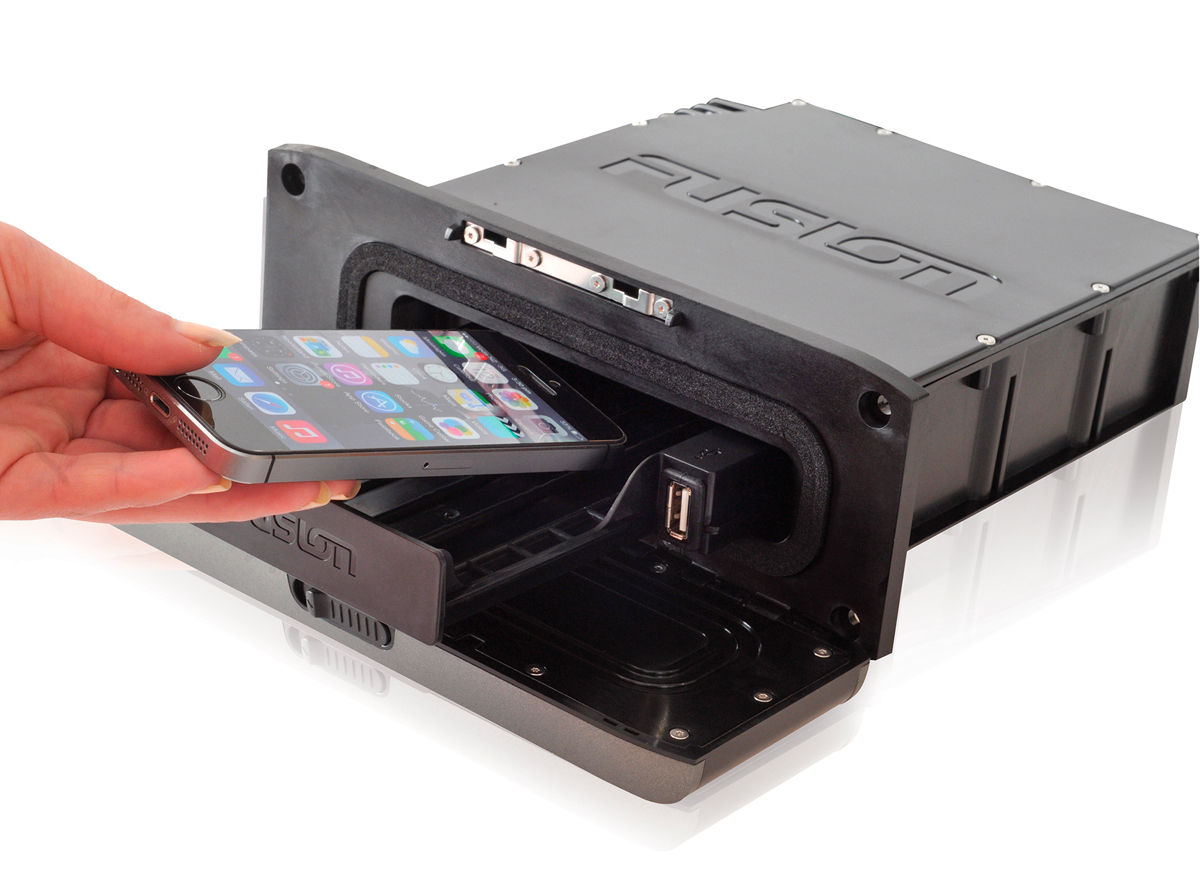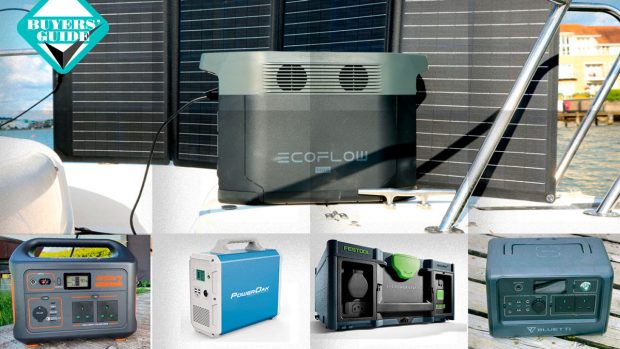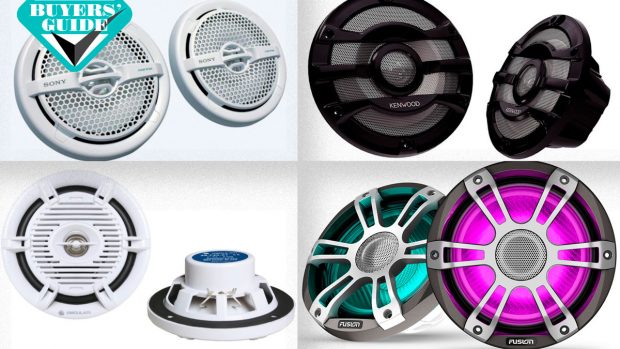Dave Marsh examines a host of boating stereo systems from JL Audio, Fusion, Marine AV and Naim
There’s no doubt that moving sound into the digital domain has helped music-loving boaters more than most. Vinyl may be making a welcome comeback, but I’ve not yet seen any IPX5-rated turntables.
Connectivity that includes Bluetooth, wireless, iPod/Pad/Phone, USB, NMEA2000 and ethernet, plus streaming services and digital music servers (hard disc drives which store and dispense digital media including sound) mean that the easy transportation and transfer of music on to your boat no longer even warrants discussion.
This mushrooming of choice has spawned a mind-boggling panoply of options for your marine speakers.
At its most simple, you could connect your i-thingy or Android device to Bluetooth-enabled waterproof speakers such as the TDK Trek A34 and stream music for a supremely flexible and installation-free set-up.
At the other end of the scale lie full domestic multi-room AV installations with such niceties as a wearable sensor that turns the music on in the appropriate area as the owner roams through their boat.
Somewhere in the middle lie dedicated marine hi-fi companies such as JL Audio and Fusion. JL Audio kindly invited me to test its latest equipment, on dry land but also on a blustery day in Poole harbour on a 70-knot RIB.
 That was followed by a visit to Fusion, where I listened to and played around with one of its top-end boating stereo systems, complete with its new Signature speakers.
That was followed by a visit to Fusion, where I listened to and played around with one of its top-end boating stereo systems, complete with its new Signature speakers.
To provide a reference point for quality, on both occasions I took along a dozen disparate test CDs that I’d previewed on my own eclectic domestic hi-fi system. At circa £9,000 it’s far from top end, but it’s not bad.
I also auditioned Naim’s £895 mu-so system because it probably represents the pinnacle of one-box wireless music, and as such could be effortlessly installed inside a motor boat, providing it was suitably protected from the elements.
Finally, I had my ears tested! Apparently, my right ear has a slight dip in sensitivity around 5kHz, but otherwise my hearing was deemed fine for a 57-year-old bloke.
What follows are sound bites from an immense soundstage, but hopefully sufficient to provide a starting point.
Streaming and compressed audio
Most streaming services run at 320 kilobytes per second (Kbps) or thereabouts, the same quality as typical MP3 downloads.
Listened to in isolation, these sound okay, but pitched against music from the so-called ‘lossless’ CD standard of 1,411Kbps (16 bit/44.1kHz) the 320Kbps music sounded second-rate.
If you use your phone to stream music, it may well be in an even more compressed form such as Spotify’s ‘high quality on mobile’ setting of 160Kbps.
 Fusion played an identical track from Spotify at its 320 and 160 settings, and the more compressed counterpart sounded terrible, as though a thick plastic sack had been dropped over the speakers.
Fusion played an identical track from Spotify at its 320 and 160 settings, and the more compressed counterpart sounded terrible, as though a thick plastic sack had been dropped over the speakers.
Even Naim’s universally acclaimed 6x75Watt amplified mu-so sounded so-so with 320Kbps music, at least to my ears.
If sound quality is remotely important to you, my recommendation is that you only stream from one of the premium providers such as Tidal or Rdio that offer the full-fat 1,411Kbps service.
Sound quality
Based on my listening tests, I reckon that if you want the ultimate in sound quality, nothing will beat a conventional high-end domestic 240V system.
There are also numerous ways of upgrading on an ad hoc basis that don’t involve core system changes. However, this assumes that you have the requisite space inside, and that the system could be sheltered from the elements.
Nevertheless, that system’s sound could still find its way outside courtesy of Fusion or JL Audio waterproof speakers.
 Curiously, although it makes amplifiers and a multiplicity of speakers, JL Audio does not make head units as Fusion does, although it does have a new weatherproof MBT-RX Bluetooth receiver, so streaming is easy.
Curiously, although it makes amplifiers and a multiplicity of speakers, JL Audio does not make head units as Fusion does, although it does have a new weatherproof MBT-RX Bluetooth receiver, so streaming is easy.
Consequently, my CD listening tests on JL Audio’s equipment came courtesy of Clarion’s waterproof head units. To my ears, the acoustic quality of JL Audio’s systems (I heard three in all) was distinctly superior to the Fusion system I heard.
As with all hi-fi, it’s difficult to separate the strands – was it the head unit, the amplifier, the speakers, or a symbiotic combination?
Although I trust my ears, for a second opinion I called one of Britain’s premier RIB builders, and its head of production said that it fits Fusion boating stereo systems as standard because of its amazing connectivity, but installs JL Audio when a customer demands the best audio quality.
Connectivity and versatility
Fusion and JL Audio are not the only players. If your boating stereo system needs to withstand the elements, by far the best single source I found for alternatives was an outfit called Marine AV who handles marine hi-fi from Alpine, Clarion, JBL, and Sony, among others.
Marine AV also stocks a range of waterproof housings, so if you have a great hi-fi head unit in your car, an option is to replicate that on your boat, install a housing, and add speakers as required.
However, when it comes to connectivity and functionality, I found nothing remotely as comprehensive as Fusion’s boating stereo systems.
Fusion-Link provides integral wireless, Bluetooth and HMDI, and Fusion’s units also have NMEA2000 and ethernet, which allows on-screen control from the luxury of a connected chartplotter.
 This is significant because I found Fusion’s albeit unfamiliar menus difficult to navigate on the small display – no surprise given their unavoidable complexity.
This is significant because I found Fusion’s albeit unfamiliar menus difficult to navigate on the small display – no surprise given their unavoidable complexity.
Although I couldn’t test drive this particular function, navigating Fusion’s menus from a giant screen should be far easier.
The connectivity doesn’t end there. Most head units have iPod/MP3 connections of some sort, and Marine AV sells numerous external iPod/MP3 connectors, but on Fusion’s head units iPod and other mobile devices dock directly inside the IPX5 rated units, where they are also charged.
Likewise, Poly-planar has an add-on multi-zone system, but Fusion’s 750 units sport integrated four-zone controls.
Boating stereo systems verdict
How rivals fare against Fusion and JL Audio on the audio quality front I can’t say – Marine AV is a great place to start for advice.
The good news is that you don’t seem to pay a premium for the marinisation of Fusion and JL Audio’s products.
Fusion’s connectivity and versatility is second to none, and JL Audio’s sound quality is terrific for its price: if you powered its most expensive (£260) M-series subwoofer and priciest (£500) new top-end M880 coaxial speakers with its finest (£700) 1,000W 5-channel amplifier, you could still buy the most expensive waterproof head unit Marine AV sell (£350) and have change from £1,900.
Buy 330W Fusion SG-TW10 Signature Series Tweeters on Amazon (UK)
Buy Fusion SG-SL10SPC Marine Signature Sports LED Subwoofer on Amazon (UK)
Buy JL Audio Full Range Class D 1000 Watt 5 Channel System Amplifier on Amazon (UK)









